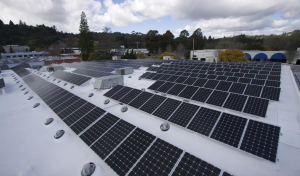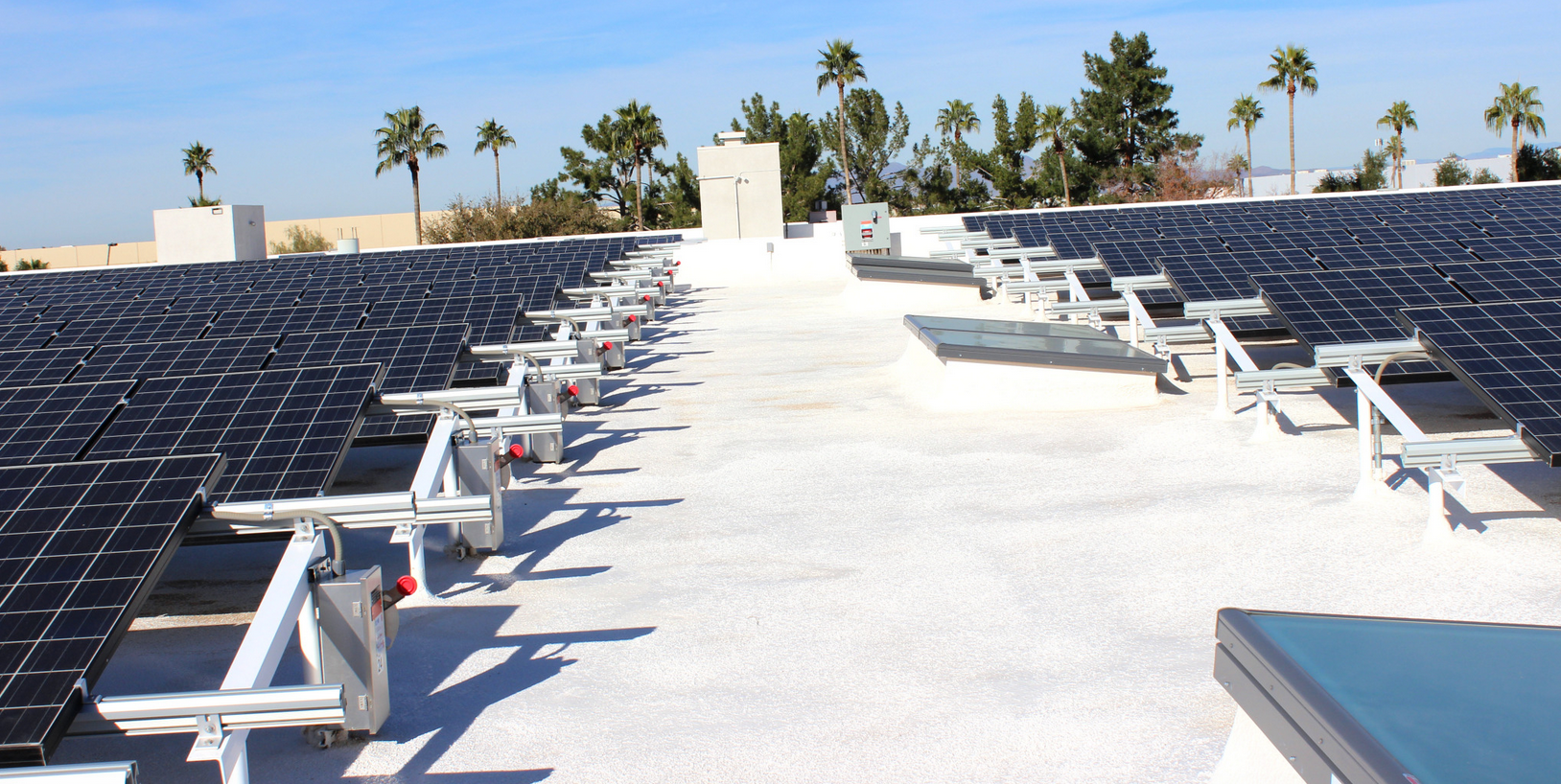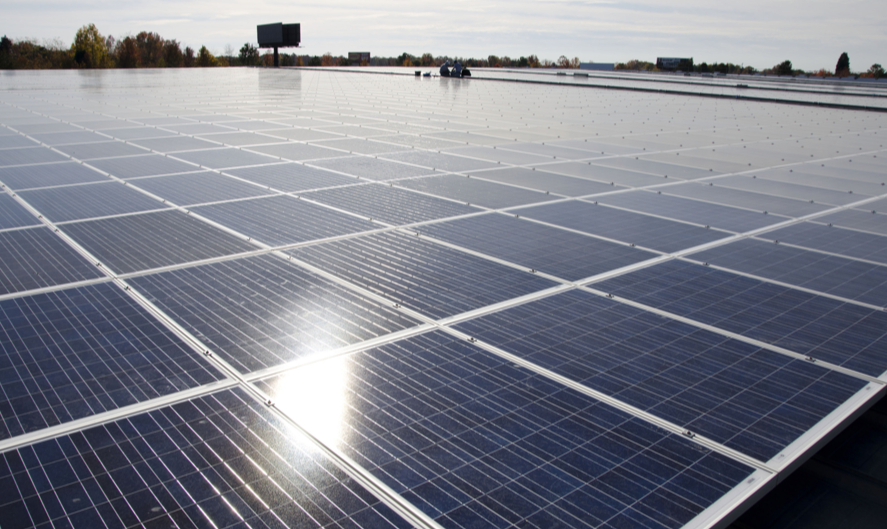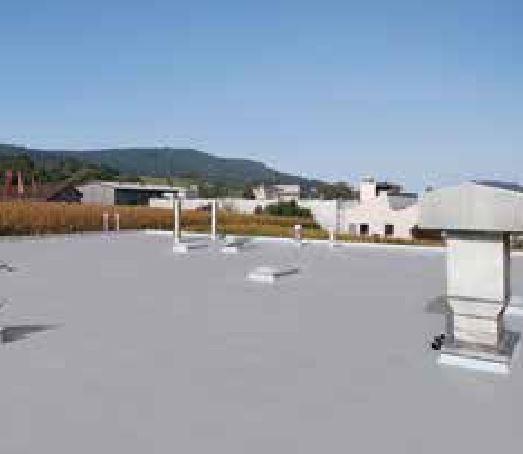Spray polyurethane foam and photovoltaic systems are increasingly utilized together as
a joint solution for energy savings. With the continued push toward sustainability and growing
movements, like net-zero-energy construction, SPF and PV systems are a logical combined solution for the generation of renewable energy, the conservation of heating and cooling energy, and the elimination of the structure’s dependence on fossil-fuel-consuming electricity sources. Regardless of whether net-zero energy is the end goal, SPF and PV combined in roofing can be quite effective for many structures. Here are some considerations when looking to join these two powerful systems on the roof of a building.
ROOFTOP PV INSTALLATION TYPES FOR USE WITH SPF

Installation of PV systems on SPF roofing will inevitably create additional foot traffic. It is important to protect heavily trafficked areas with additional coating and granules or walk pads.
Rooftop PV systems can vary significantly in size. Large-footprint buildings can employ PV systems rated from 50 kilowatts to 1,000 kW or larger while residential rooftop PV systems are commonly 3 kW to 5 kW.
Rooftop PV systems may be installed on racks or adhered directly to the roof surface. When looking to combine PV with SPF, it is generally not advised to adhere or place the PV panels directly onto the roof surface. Solar heat and water can accumulate between the PV and roof coating which could negatively impact coating performance. Moreover, panels applied directly to a low-slope roof will not be properly aligned with the sun to achieve optimal performance.
Non-penetrating rack systems may be placed directly on a rooftop and held in place with ballast. Racks may also be installed with penetrating supports that require flashings. Each type provides advantages and disadvantages. For example, ballasted racks may block water flow and affect drainage while penetrations require leak- and maintenance-prone flashings. SPF is unique in that it easily self-flashes around penetrating supports.
PV EXPLANATION
PV cells are the basic unit used to convert light to electricity. Many PV cells are bundled together to make a PV panel, or module. PV panels are grouped electrically to create a PV string. Depending on the system size, two or more strings are combined to create a PV array.
The dominant type of PV panel used with SPF roofing is cSi, or crystalline silicon. cSi is a typically rigid panel with a glass and metal frame and may be applied, unlike other dominant PV panel types, via rack installation methods.
A PV system includes many components in addition to the panels. Components include racks, rails, rooftop attachment devices, grounding systems, wiring and wiring harnesses, combiner boxes, inverter(s) and connection to the main electrical panel. Components may also include control modules and storage batteries for off-grid PV system installations.
ELECTRICAL SAFETY
Photovoltaic panels must be handled and maintained with caution. Electricity is produced when a single panel is exposed to light; however, because a panel is not part of a circuit, that electricity will not flow until the circuit is complete. A worker may complete the circuit by connecting the two wires from the backside of a PV panel.
When maintaining a PV system, it may become necessary at some point to disconnect or remove an individual panel from a string or an array. The whole system must be shutdown properly as a precautionary measure to prevent shocks from occurring to workers and arcing between electrical connections. This “shutdown” procedure must be followed with precision as part of a lock-out/tag-out program. This procedure is provided by the inverter manufacturer. Under no circumstances should SPF contractors ever disconnect or decommission a PV panel or system unless they are trained and qualified to do so.
HEAT BUILDUP
Photovoltaic panels convert approximately 15 to 20 percent of light to electricity, leaving the remaining unconverted energy to be released as heat. Additionally, PV panels are more effective when their temperature drops. It is for these reasons that the majority of rooftop PV systems are installed to encourage airflow under panels, which reduces the temperature of the panels, improves conversion efficiency and releases heat effectively. Photovoltaic panels installed 4 to 5 inches above the roof will not change the temperature of the roof and, instead, provide shade to the surface of that roof. This additional shade may extend the life of SPF roof coatings.
LOAD
PV panels add weight to a rooftop and this must be factored into the design and installation. Existing structures should be analyzed by a structural engineer to determine if the additional weight of the PV system is acceptable.
Rack-mounted arrays with penetrating attachments are fairly lightweight at 2 to 3 pounds per square foot, and ballasted arrays add 4 to 6 pounds per square foot. However, with the latter, more ballast is utilized at the perimeters and corners of a PV array. Thus, localized loading from ballast may reach as high as 12 to 17 pounds per square foot, which must be considered. Most SPF roofing systems have a compressive strength of 40 to 60 psi.





Be the first to comment on "Spray Polyurethane Foam and Photovoltaic Roofing Systems"